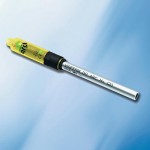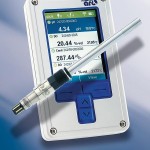Sensors supply control systems, diagnostic tools or process control instruments with a lot of information. In order to be ready for the future, sensors must be perdurable and integrate easily into many applications. In addition, the data they provide must be highly accurate. Hamilton has taken this task upon itself and made a firm commitment to the future with targeted enhancements to the Arc product family.
The author: Michael Beyrau Redaktionsbüro Faktum
The advantages of the Arc sensors are obvious: by integrating the transmitter in the sensor head, there are fewer interfaces and the quality and reliability of the measured values increases. The ability to configure and control up to 30 different sensors with a handheld device simplifies work processes – and even facilitates maintenance. Hamilton’s Arc systems therefore offer leaner process cycles. Interference currents due to humidity, long cables or other signal disturbances are a thing of the past.
Measurement of redox potential
Arc sensors are well established when it comes to monitoring and controlling industrial processes. Apart from safely measuring pH, dissolved oxygen or conductivity, they are now also capable of recording the oxidation reduction potential (ORP) of a substance. In this case, they measure the voltage as a function of the substances in the solution.
With two single pores, Polilyte Plus ORP allows direct contact between the electrolyte and the medium, thus ruling out disruptions at the measuring point. It is primarily used in the chemical industry and water treatment. EasyFerm Plus ORP is employed in biotechnology and in the pharmaceutical industry. The pre-pressurised reference system ensures an obstruction-free diaphragm while the platinum ring serves to measure the potential. Oxidation reduction potential can be measured between ±1500 mV with ±0.5 mV repeatability at 25 °C.
Arc speaks Hart
VisiFerm DO Arc Hx is the first optical oxygen process sensor with an integrated transmitter that is capable of communicating via the platform-independent Hart (Highway Addressable Remote Transducer) system – allowing digital information to be exchanged between the sensor and the host. This information is transported according to the usual 4 to 20 mA standard as well as simultaneously via analogue signals.
Following many years of successful use, the Hart data protocol is by far the most popular in the process industry today. The installed base amounts to more than 30 million applications and devices worldwide. By installing the Hart interface on the Arc sensor, Hamilton incorpo-rates this widely used industry standard to permit easy implementation in existing installations.
Atex approval guarantees safety
In segments like the chemical industry, process sensors must comply with special requirements. Hamilton now offers the new VisiFerm DO Arc Hx with Atex approval especially for applications in this environment. This optical process sensor is licensed for zones 0 and 1 (now Classes 1 and 2). VisiFerm DO Arc Hx can consequently be used at all locations where dangerous, potentially explosive mixtures of air and combustible gases, vapours or mists are present. The Atex approval applies to both the sensors and the handheld device.
VisiFerm DO Arc Hx is approved for temperatures from -10 to 130 °C and a maximum pres-sure of 12 bar. The silicone membrane where the oxygen measurement takes place is fastened to a stainless steel cap and screwed to a stainless steel shaft. The novel components installed inside the sensor have the usual computing power and measurement accuracy but occupy less space and generate very little heat. The sensor has also been approved for hazardous areas for these reasons. VisiFerm DO Arc Hx with Atex approval is mainly used for monitoring dissolved oxygen in gas-phase reaction mixtures.
The product family
Hamilton is represented in the market with three Arc concepts tailored to the most varied customer requirements. Arc Vital offers a direct connection from the sensor to a control system via a 4 to 20 mA interface and is the basic so- lution for classic users such as research and pilot laboratories. Arc Versa was developed for planners or OEMs looking for sensors that can be easily integrated. It allows up to 30 analogue sensors to be connected to the control system and is used in building skid plants in which several sensors are installed within one measuring system.
In new plants and installations, the full potential of the Hamilton technology is unleashed by Arc Vision. Arc sensors can be operated and maintained simultaneously in digital mode. Wired or wireless communication is possible, so that sensor installation, handling and maintenance – and process control – are now easier, more reliable and more efficient.
Measured and diagnostic values can be read directly at the point of installation using the Arc View handheld, which also allows calibration and configuration. Owing to the flexible communication concept, Arc sensors are straightforward to integrate and offer time-saving options for operation and maintenance.
Optimal sensor monitoring
The Hamilton Device Manager was developed to control sensors with the help of computer-based diagnostic software. The application relies on a standardised field device tool (FDT), a multiple manufacturer concept for parameterising field devices. As the successor to the Arc Sensor Configurator, the Device Manager now also supports ModBus, Hart, Profibus, Foundation Fieldbus, DeviceNet, Interbus and AS-Interface. More fieldbus protocols will follow in the near future. This independence of specific platforms simplifies sensor configuration, operation and servicing.
cpp-net.com/0312423
Bright prospects for advanced sensors

Equipped for the Future
cpp: Hamilton is one of the leading sensor manufacturers. Which strategy do you intend to follow to secure this position in the long term?
Pochert: Innovative, high-quality products, competent sales and distribution and outstanding service. Hamilton sensors are among the best in the market. Our Arc System allows unique communication versatility and that’s what sets us apart. What’s more, process analysis products always require a certain amount of explanation – and this is exactly where our local organisations and their services meet the consulting need.
cpp: In which market segments are Hamilton sensors primarily used today and with which applications would you like to gain new market shares?
Pochert: We focus on the pharmaceutical and biotech segments, where Hamilton products fully satisfy customer requirements and to some extent even exceed them. However, other segments such as the chemical and food industries are also becoming increasingly important for us.
cpp: As a family-owned company, Hamilton typically does not divulge any figures. Nonetheless: how would you assess your sales trend compared to your competitors? Who is number one and where do you rank Hamilton?
Pochert: Like other areas at Hamilton, process analytics has experienced strong growth in recent years. In the core market segments we have undoubtedly created a good position for ourselves. Our rivals are well-known; some of them lead in terms of time, but many of our products – from the VisiFerm DO optical sensor and the Arc System all the way to the new optical dissolved oxygen measurement devices for hazardous areas – are way ahead of the competition. Unfortunately, our products are also copied – not only by Asian manufacturers. Yet in the end, we feel this is confirmation that we are on the right track.
cpp: Which market objectives would you formulate for Hamilton for the next few years?
Pochert: Technically speaking, we will remain very innovative and surprise customers with impressive solutions. Hamilton will establish itself as one of the world’s best and hold this market position in the long term.
Share:








